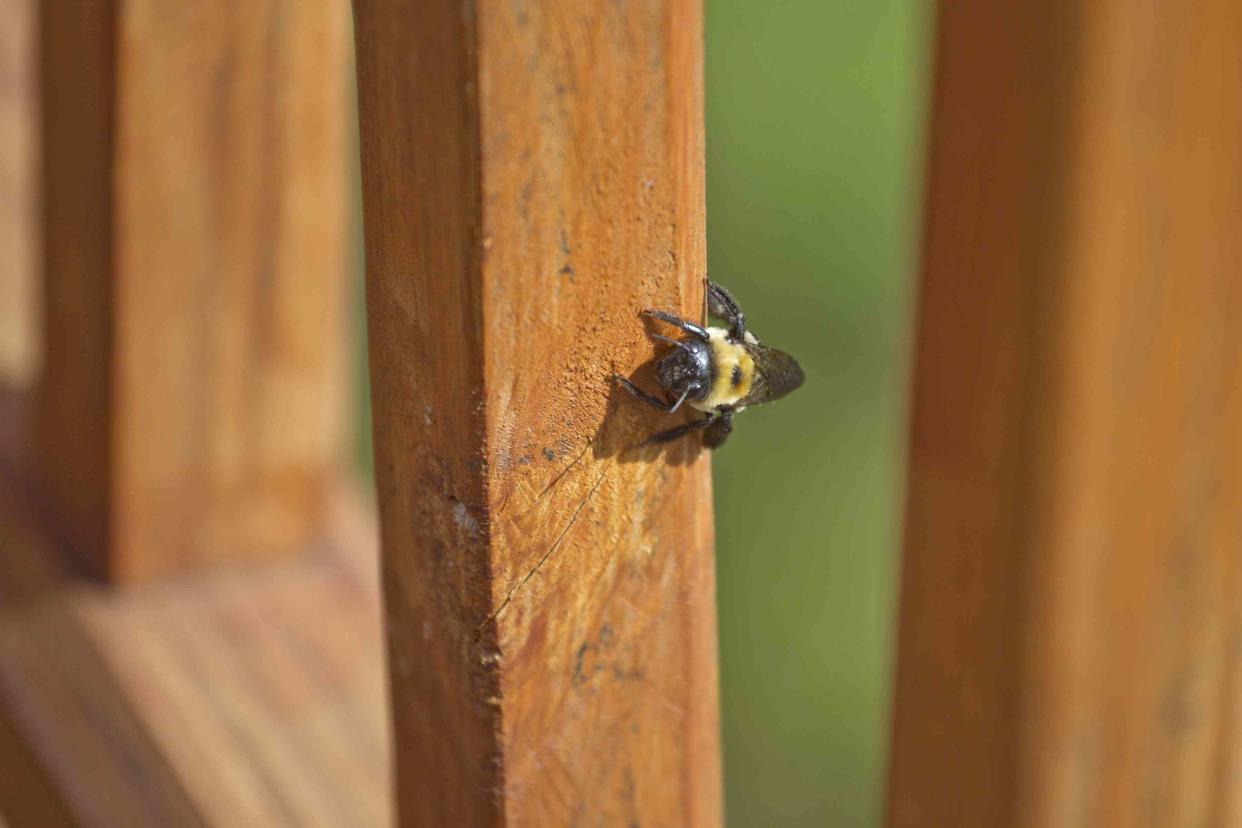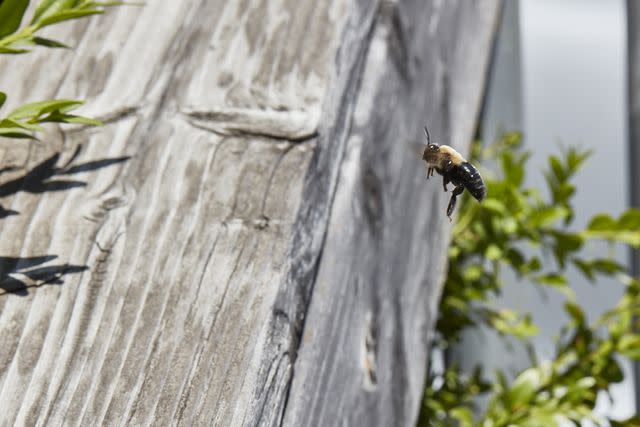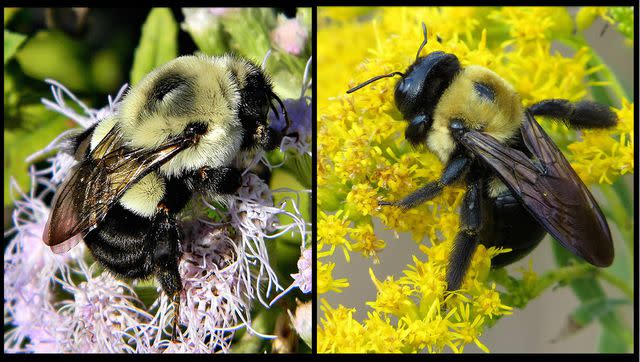How to Get Rid of Carpenter Bees That Are Bugging Your Home in 4 Steps

AwakenedEye / iStock / Getty Images Plus
Carpenter bees sound like industrious creatures, but trust us—you don’t want these “helpers” anywhere near your home. While pollinators are important to the ecosystem, carpenter bees are destructive and must be dealt with quickly to avoid damage to your property.
Read on to learn how to get rid of carpenter bees creating a buzz in your home according to experts.
Meet the Expert
Shannon Harlow-Ellis is the associate certified entomologist at Mosquito Joe.
Jim Buick is an associate certified entomologist at Fox Pest Control.
What Are Carpenter Bees?

The Spruce / Margot Cavin
With pest control, it’s important to know what you’re dealing with before you hatch a game plan. And when it comes to bees, you’ll need to first determine whether you’ve got a swarm of bumble bees or carpenter bees buzzing about before attempting any pesticides or natural pest control methods.
Carpenter bees share a striking resemblance to bumble bees, which can make it hard to differentiate the two, according to Shannon Harlow-Ellis of Mosquito Joe.
While we don’t advise getting too close to examine them, she says there is a defining characteristic that sets them apart: carpenter bees don’t have hair on their abdomens, so they present a smoother appearance than their bumble bee counterparts.
4 Ways to Get Rid of Carpenter Bees
There are several ways to eliminate the threat of carpenter bees. Choosing one will depend on the severity of the swarm, though you might want to follow one or more of the following methods for a quicker resolution.
Apply Insecticide Sprays and Dusts
Buick says the pros apply insecticidal dust right into the dug-out chambers of the carpenter bees. Then, they apply a residual liquid application to any exposed wood nearby to prevent carpenter bees from taking up residence there.
In addition to wooden siding, decks, and window frames, Buick says points of concern would be exposed fascia wood along the roofline, door trims, fencing, and any ornamental structure, like pergolas.
Buick recommends spraying in early spring, such as April and early May, when you might first notice bee activity.
Plug the Holes
While immediate attention is necessary to protect the integrity of the wooden structures on your property, Harlow-Ellis says prevention might not be all that labor-intensive.
“Simple measures like filling holes with a durable substance or wood putty, sealing them with caulk, and wrapping untreated wood in vinyl can provide protection,” she says.
She adds that sealing or painting wood is another way to ward off carpenter invasions, so this might be the time to restain your deck.
Spray Natural Repellents
Lavender oil, citronella oil, and the citrus scent in general are known to be highly repulsive to carpenter bees, Buick says. Take advantage of this knowledge by filling a spray bottle with water, adding some drops of essential oil—pick your favorite from among the ones carpenter bees hate—and spraying near wood structures to keep the bees at bay.
Install Traps
Carpenter bee traps are exactly what they sound like—they lure and trap bees until your pest problem is solved. These traps are made from wood because that’s what the bees are after in the first place. They're usually easy to install on your house or other structures.
The trap typically has angled holes that will draw the bees in. Happy to have gotten a break from doing all the work for once, the bee will emit a signal from the inside that will attract other bees. The trap also has a glass mason jar at the bottom into which the bees will fall and remain trapped because the opening is larger than their wingspan.
Carpenter bee traps, which can also lure other bees, are easily purchased online or at your local home improvement store.
The Difference Between Carpenter Bees and Bumble Bees

Flickr users Bob Peterson (CC by SA license) and David Hill (CC license)
Bumblebee (left); carpenter bee (right)Carpenter bees are slightly larger than bumble bees, plus you might notice that they have a distinctive flight pattern. Rather than the more direct line bumble bees follow—it’s not called a “beeline” for nothing—carpenter bees move through the air like they’re chasing each other.
Oh, and they’ll likely be boring into wood in and around your home, which is something bumble bees won’t do.
“Carpenter bees certainly have a place in our ecosystem and are important pollinators of many flowering plants—but they become pests when they cause potential damage to wooden structures inhabited by humans,” Jim Buick of Fox Pest Control says.
Regarding the threat of stings, only female carpenter bees have stingers, and they won’t be too inclined to use them against humans—unless you provoke them or try to do some burrowing of your own in the holes they’ve bored in wood.
Why Do Carpenter Bees Drill Holes?
Unlike the more polite bumble bee that might simply hang out in an already existing hole or cavity, carpenter bees—namely the females—take it upon themselves to create their own.
Like any other insect trying to make it in the great outdoors, a carpenter bee is simply trying to find comfy spots to lay their eggs. That’s why female carpenter bees bore holes through wood, making individual spots for eggs.
It’s easier for these hard-working expectant mamas to work with wood that’s unfinished or worn out. Softwoods make the work easier, though some carpenter bee species prefer hardwood nurseries to protect their developing larvae.
It takes just a couple of hours for carpenter bees to chew a hole a few inches deep with their strong mandibles—insect talk for a jaw.
What Level of Damage Can Carpenter Bees Cause?
Quite a bit, according to Harlow-Ellis. The females are rather creative in their nesting behavior, with tunnels taking sharp turns following the direction of the wood grain.
“Over time, females may enlarge existing galleries or utilize old ones, creating an intricate system,” Harlow-Ellis says, and adds that common hot spots for carpenter bees are wood siding, deck rails, and even window frames.
If this sounds like a major threat to your home’s structure, you’d be right. But it could get even worse.
“The damage intensifies when birds prey on carpenter bee larvae, causing additional harm by pecking holes in the wood surface to access the larvae,” Harlow-Ellis says.
When to Call a Professional
Spotting one or two carpenter bees isn’t necessarily cause for immediate concern. But that’s of little relief to you if you’re allergic to bee stings. Again, while carpenter bees will usually leave you alone, female bees can sting if they feel threatened, says Harlow-Ellis.
Then, there’s the potential structural damage to consider. “The decision to seek professional help hinges on the extent of damage and other risks,” she says.
Frequently Asked Questions
What will keep carpenter bees away for good?
Buick recommends painting or staining wood to prevent future attacks. You should also insert wooden dowels or apply wood putty to cover up chamber holes—late summer and early fall are a good time to do this.
What smell do carpenter bees hate?
Buick says citrus is positively repellent to carpenter bees, as is lavender oil and citronella oil. Pick the one that you don’t mind smelling and mix a few drops of the essential oil with water. Fill a spray bottle, then spray near wood structures and other spots where you suspect bees might be hanging out.
Can carpenter bees sting you?
Male carpenter bees don’t have stingers, but the females sure do. They probably won’t even attempt it unless you’re trying to touch one or are sticking your fingers in the holes they’ve burrowed; obviously, neither action is advised.
How can I get rid of carpenter bees without killing them?
Painting unfinished wood can help, as it makes the surface that much more difficult to bore through. So can filling in any holes with dowels or wood putty to keep bees from burrowing. And as already mentioned, citrus and other essential oils like lavender and citronella do a good job of offending carpenter bees.
Read the original article on The Spruce.

